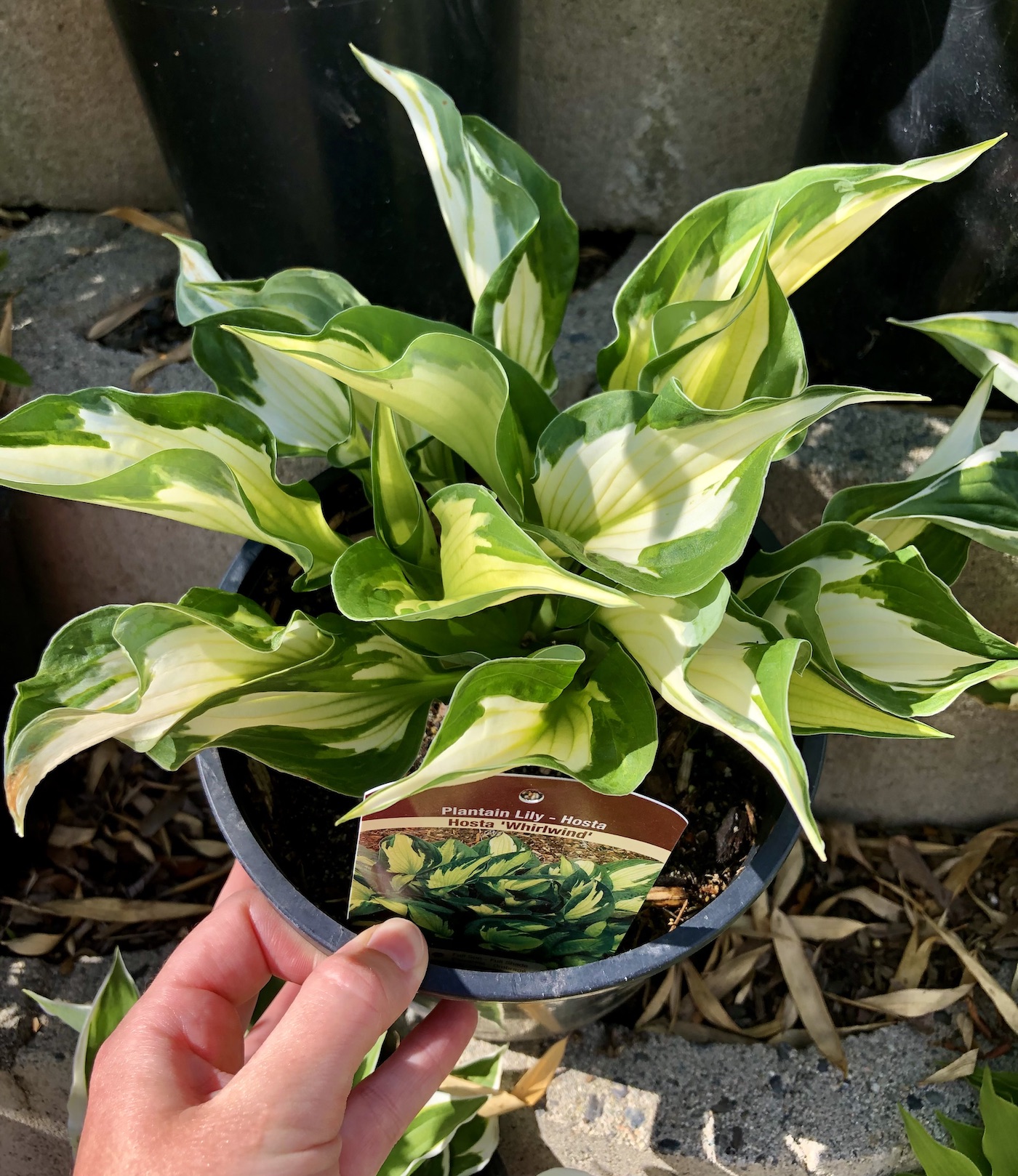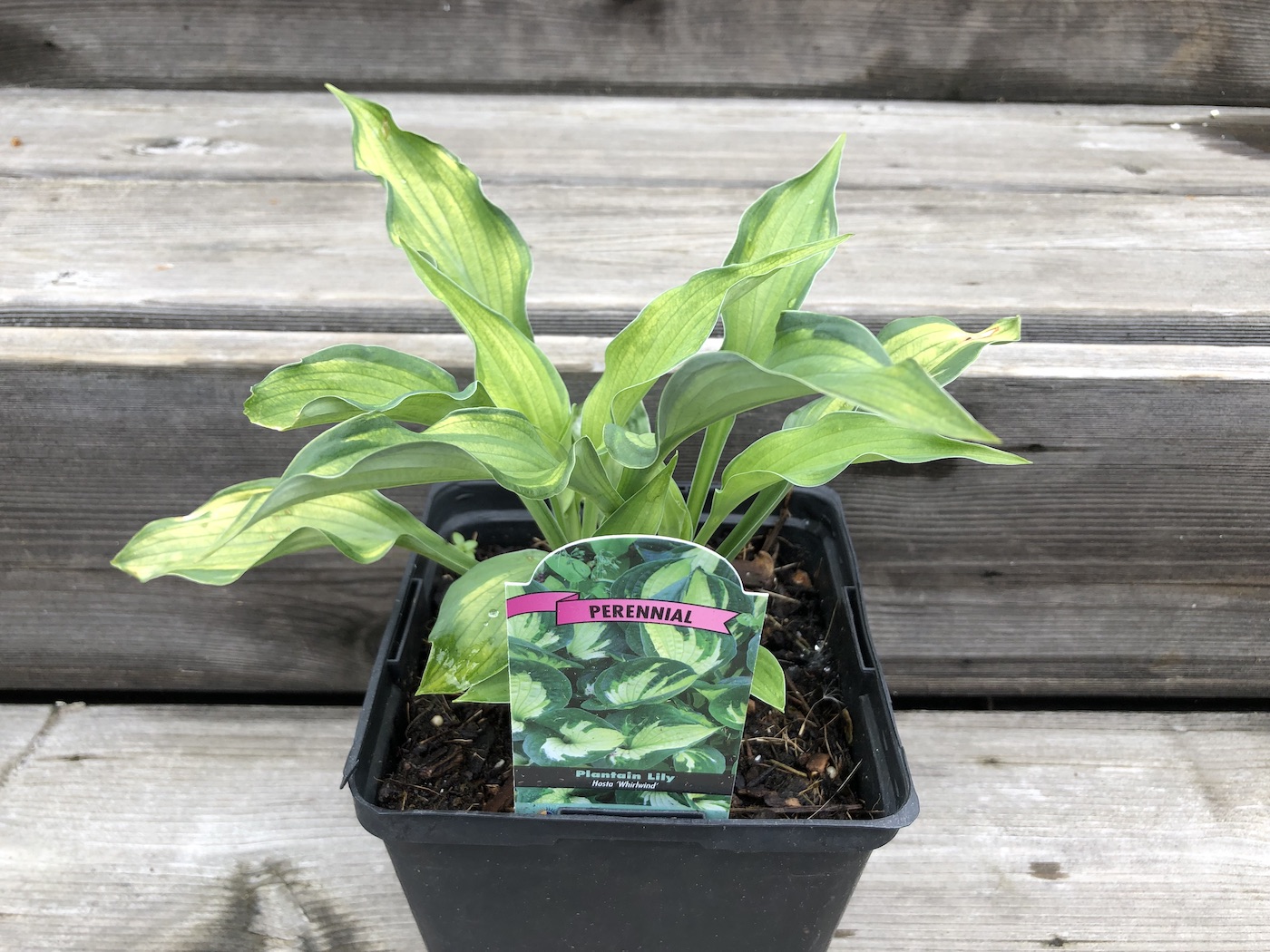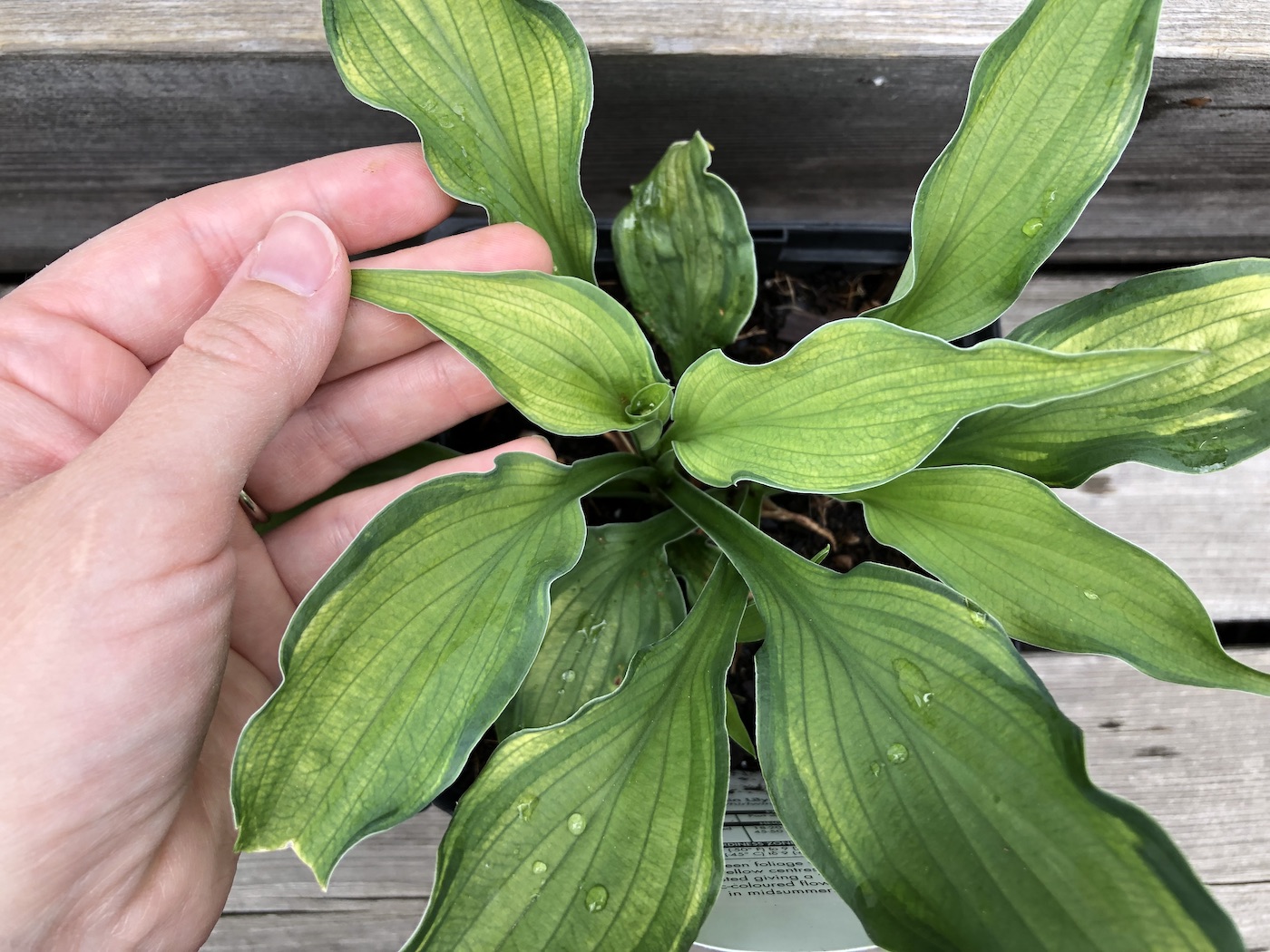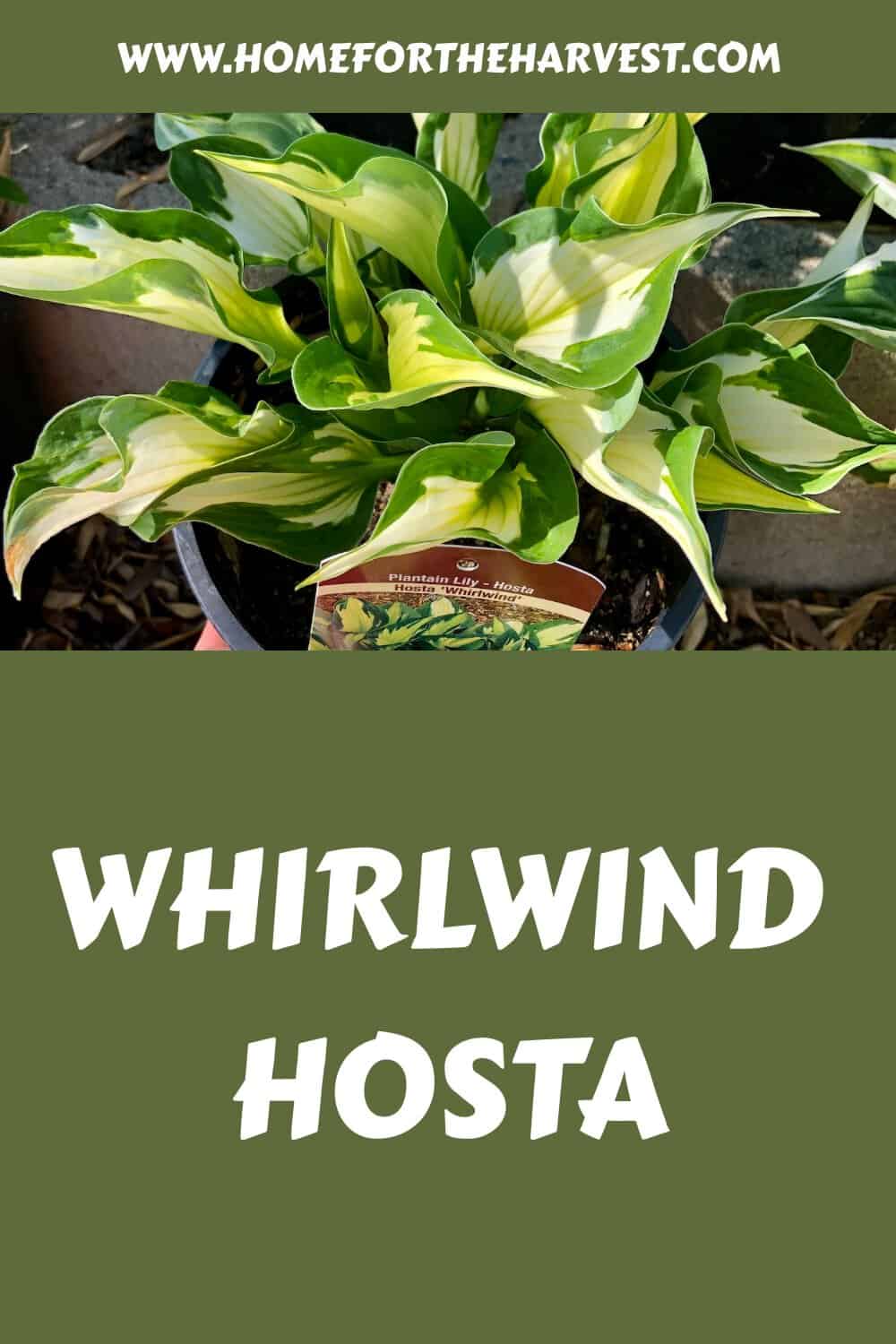The Whirlwind hosta is a variegated medium-sized hosta known for its unique twisted leaves. This beautiful variety has leaves of bright chartreuse yellow-green with irregular dark green edges. Whirlwind grows best in partial shade to partial sun and is often used as a groundcover plant. This is one of the easiest hosta varieties to grow.
Whirlwind hosta basics
The Whirlwind hosta is a specialty variety with an unusual twisted leaf shape and bright color. These plants typically grow to about 40 inches wide and 18 inches tall. This variety has pale purple flowers that bloom on 20-inch stalks right above the bright leaves. While the exact parentage of this popular variety is not known, it is thought to be a sport or descendant of Hosta ‘Fortunei Hyacinthina’.
Where to plant Whirlwind hosta
Whirlwind hosta can be grown in zones 3-9. In general, hosta plants grow best in partial shade to partial sun. As for soil, it prefers well-drained sandy loam that’s on the acidic side. Mature whirlwind plants grow to be about 40 inches wide, so be sure there’s enough space for the plant in the garden.
Sunlight for hostas
Whirlwind hosta is a variegated variety typically grown in either partial sun or shade. It will tolerate full sun in the morning in all but the hottest zones(and the contrast on the leaves will even improve), but its leaves may scorch if the sun is too hot in the afternoon or if the plant does not have enough water. The best planting spot is generally a location with a few hours of direct sunlight in the morning, followed by midday and afternoon shade.
Soil requirements
Whirlwind hosta plants tend to grow best in well-drained sandy loam soil. Assuming they have enough water to thrive, the plants are quite vigorous in loose soil. Whirlwind is tolerant of clay soil, but the plants will grow more slowly. Try to avoid planting them in low spots where water pools.
In terms of pH, hostas prefer slightly acidic soil. A soil pH of about 6 is optimal but not strictly necessary. Do a soil test and then use an organic soil acidifier if your soil is alkaline.

When to plant a hosta
The best time to plant a hosta is in the spring after the last frost date. This will give your plant a chance to establish itself before the hot summer weather arrives. You can also plant them in the fall, but they are less likely to be available from garden centers and online plant nurseries in autumn.
How to plant Whirlwind hosta
Hostas are easy to plant, and Whirlwind is no different. Before planting, water your hosta plants thoroughly and then allow them to drain. Also, take care to keep them out of direct sunlight before planting them.
Start by digging a wide shallow planting hole. The hole should be twice as wide as the pot your plant is in but only just as deep. This will give the roots plenty of room to spread out laterally without burying the crown too deeply.
Once you’ve dug the hole, loosen the roots of your whirlwind hosta plant and then place it in the hole. The crown (where the leaves meet the soil) should be level with the soil surface. Backfill the hole with loose soil, being careful not to bury the crown. Water your plant well and give it a little extra water if the weather is hot and dry.
Fertilizing hostas
Hostas are relatively heavy feeders and will benefit from being fertilized every few months in the spring and early summer. Use a slow-release organic fertilizer or a water-soluble fertilizer designed for use on acid-loving plants. Be sure not to over-fertilize, which can burn the roots and damage the plant.
Watering Whirlwind hosta plants
Whirlwind hostas should be watered quite often after planting. The soil should be kept moist but not soggy. During hot weather, whirlwind hostas may need to be watered every couple of days or even daily. In general, hostas do not like to be allowed to dry out completely.
Once the plant is established, it will need less water. Whirlwind hostas are drought tolerant once they’re established, but they will appreciate being watered during periods of extended heat and drought. Hostas are native to very rainy areas in Asia and typically thrive with quite a bit of water (as long as they aren’t in puddles of standing water).
Pruning Whirlwind hosta
Whirlwind hostas don’t require a lot of pruning, but you can cut them back in the late fall or early spring to remove spent foliage. The only pruning they really need during the year is removing dead or damaged leaves at their base.

Plant care tips for Whirlwind hosta
Hostas love moist soil and do well when the soil surface is mulched with organic mulch like compost or hardwood mulch. You’ll also want to keep the area well-weeded when the plant is young to help it establish (although mulch will help with this too). Hostas don’t require division, but you can certainly dig up, divide, and transplant your hosta if you’d like more plants.
Companion plants for Whirlwind hosta
Here are some plants that might complement your Whirlwind hostas:
- Ornamental grasses: Tall varieties like miscanthus or shade-tolerant types like Japanese forest grass make a great backdrop for shorter hostas.
- Ferns: These shade-loving plants are the perfect complement to hostas. Try lady fern, Japanese painted fern, or ostrich fern.
- Astilbes: Another shade-tolerant plant, astilbes come in a variety of colors and add interest to the garden.
- Coral bells: These low-growing plants are available in a wide range of colors and make a great ground cover under hostas.
- Hostas: Yes, that’s right! Different varieties of hosta can make a beautiful and harmonious planting. Try combining whirlwind hosta with plants like the tiny Blue Mouse Ears hosta or the giant Empress Wu hosta.

Pests affecting Whirlwind hosta
Some pests that affect Whirlwind hosta are slugs, snails, aphids, and Japanese beetles. These pests can be controlled with a variety of methods, including traps, barriers, and organic pesticides.
Slugs and snails tend to attack hostas by eating the leaves, which can cause the plant to look tattered and unsightly. One way to control these pests is to set out traps baited with beer or a mixture of molasses and water. You can also try barriers such as diatomaceous earth or sand around the base of the plant.
Aphids are small, soft-bodied insects that can cause damage to plants by sucking the sap out of the leaves. They can also transmit diseases from one plant to another. To control aphids, you can use a strong stream of water to blast them off the plant or try an organic insecticide such as neem oil.
Japanese beetles are another common pest of hostas. These voracious eaters can strip a plant of its leaves in no time flat. To control Japanese beetles, you can try traps baited with a pheromone lure, or you can hand-pick the beetles off the plant and drop them into a bucket of soapy water.
Diseases affecting Whirlwind hosta
Some diseases that affect whirlwind hostas are powdery mildew, leaf spot, and crown rot. These diseases can be controlled with a variety of methods, including fungicides, crop rotation, and proper plant care.
Powdery mildew is a fungal disease that affects a wide variety of plants, including hostas. This disease appears as a white, powdery growth on the leaves and can eventually lead to leaf drop. To control powdery mildew, you can use a fungicide or take preventive measures such as avoiding overhead watering and planting in areas with good air circulation.
Leaf spot is a fungal disease that can cause brown or black spots on the leaves of hostas. This disease is often more of a cosmetic issue than a serious threat to the plant, but it can become problematic if it affects a large percentage of the foliage. You can try using a fungicide or removing and destroying affected leaves to control leaf spots.
Crown rot is a fungal disease that affects the roots and crown of hostas. This disease is often caused by overwatering or planting in poorly drained soil. To control crown rot, you can improve drainage in the area around the plant, or you can treat the plant with a fungicide.
Preventing problems with Whirlwind hosta
The best way to prevent problems with whirlwind hosta is to provide the plant with proper care. This includes planting in well-drained soil, watering only when the soil is dry, and fertilizing lightly. You should also avoid overcrowding the plants, as this can lead to problems with airflow and drainage. If you live in an area where Japanese beetles are a problem, you may want to consider treating the plants with a preventative organic insecticide in the spring.






